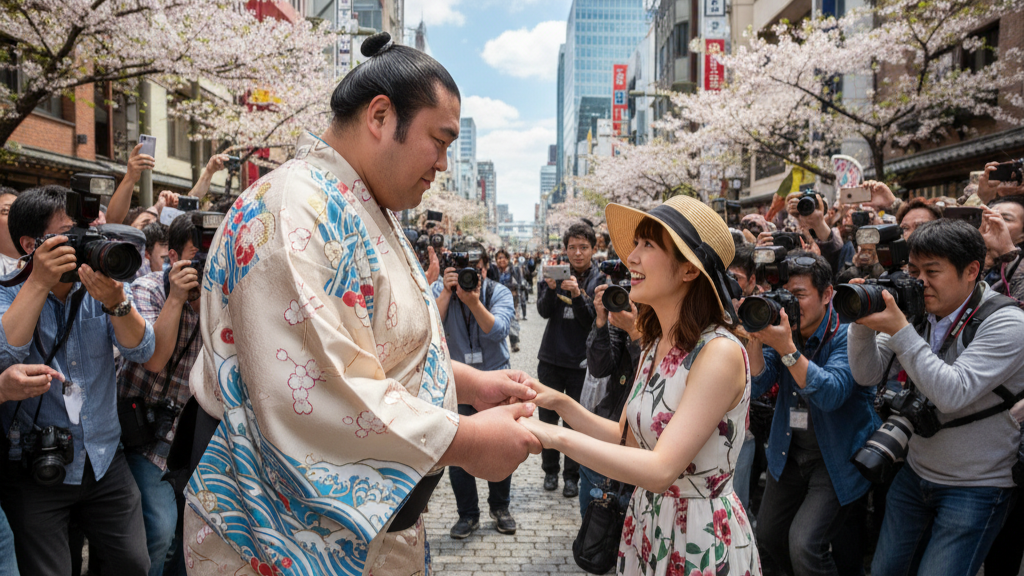Here’s a curious truth about sumo, Japan’s most traditional sport: for all the talk of salt-throwing ritual and monkish discipline, the public is quietly fascinated by the romantic lives of the men in mawashi (loincloth). In a country where the dohyō (sumo ring) is framed as sacred and sumo’s image is all stoicism and sweat, any glimpse of koi (romance) among wrestlers lands like celebrity gossip with a Shintō twist. The tension between austere tradition and ordinary human longing is half the intrigue.
The architecture of a wrestler’s private life begins in the heya (stable), where young recruits live under quasi-monastic rules and a strict hierarchy. Dating is constrained by curfews, chaperoned schedules, and the sheer exhaustion of dawn-to-dusk training. Only on becoming a salaried sekitori do wrestlers gain more autonomy—and with it the practical possibility of marriage and family. It’s a paternal system in which the stablemaster (oyakata) is “father” and his wife, the okamisan, is the “mother,” running the stable’s daily life and often acting as counselor and gatekeeper of propriety. A The Japan Times’ feature on okamisan lays out how these women manage everything from meals to money—and, implicitly, boundaries—around a house full of young men.
When love does surface, it’s often public. High-ranking wrestlers hold lavish wedding banquets; some marry media figures or models, continuing a decades-long pattern of pairing national-sport celebrities with mainstream entertainers. As an earlier Los Angeles Times snapshot noted, such marriages have been a staple of sumo’s public life since the 1990s, feeding a popular fascination with improbable couples and the private tenderness of very public giants. The saga of star Yokozuna Takanohana’s high-profile engagement to actress Rie Miyazawa—announced with royal-wedding levels of attention, then called off—became a cultural parable about the demands of the stable system and the expectations placed on a coach’s future wife.
Of course, scandal travels faster than romance. Weekly magazines have long mined wrestlers’ private lives, and in 2021 the sport faced a rough patch of tabloid revelations and disciplinary action. The Japan Sumo Association (JSA) suspended Ōzeki Asanoyama for repeated violations of COVID-19 protocols, a case that—though centered on rule-breaking rather than sex—showed how swiftly private nights out can blur into public disgrace when you belong to a sport that treats character as part of competition. That same season saw other wrestlers’ behavior scrutinized, with the JSA signaling a firmer line on off-dohyō conduct.
The rules around women and the ring also frame public curiosity about love and sex. The 2018 incident in which female medics were ordered off the dohyō as they tried to help a collapsing man was met with apologies—and with renewed debate about the idea that women “pollute” the sacred space. It’s hard to discuss wrestlers’ relationships without acknowledging the gendered strictures around the sport’s most visible stage. Even as amateur women’s sumo grows, professional sumo’s rituals still hover over how fans read intimacy, marriage, and propriety in the lives of its stars.
Yet sumo is not a cloister; it’s a community. The okamisan are culture-bearers as much as house managers; the kōenkai (supporters’ associations) become extended family; and retired greats remain symbols of everyday love and loss. When all-time great Hakuho (now Magaki) broke with the JSA this year to pursue a global project, it reminded fans that life paths—and personal values—continue well beyond competitive years. And when Akebono died in 2024, news coverage lingered on the devotion of his wife and family as much as on his historic wins, a reminder that the nation’s affection for sumo often begins and ends at home.
So if the question is whether wrestlers have sex lives and love lives: of course they do, and Japan watches with the same mixture of reverence and rubbernecking it brings to other celebrity romances—just with more incense and salt. The sport’s vocabulary gives the story its flavor: the heya shapes opportunity, the okamisan upholds the code, the dohyō enshrines a line between the sacred and the social, and the sekitori learn that with rank comes freedom—and scrutiny. In a culture that expects public figures to embody gaman (endurance) and seijitsu (integrity), every wedding photo and misstep becomes part of sumo’s living folklore. The love lives aren’t an aberration from tradition; they’re the human heartbeat beneath it.

